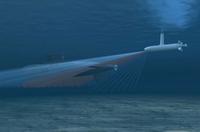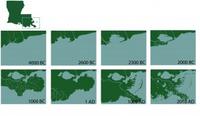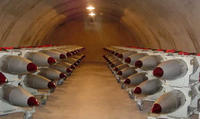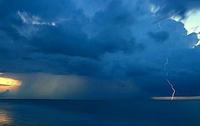-
Predicting future droughts in California

According to a new NOAA-sponsored study, natural oceanic and atmospheric patterns are the primary drivers behind California’s ongoing drought. A high pressure ridge off the West Coast (typical of historic droughts) prevailed for three winters, blocking important wet season storms, with ocean surface temperature patterns making such a ridge much more likely. The study found no conclusive evidence linking human-caused climate change and the California drought.
-
-
Bionic bra one step closer
A Bionic Bra which automatically tightens in response to breast movement is one step closer to reality with the development of a new prototype. The development of the bra is the result of findings by researchers that without the right breast support, the movement of women’s breasts during demanding physical activity – in sports, the military, first response, and more – may cause long-term damage, including numbness in the fingers caused by compression of nerves on the shoulders, as well as neck and back pain. “Unfortunately, the most supportive sports bras tend to be the most uncomfortable to wear.” Making matters worse, “research has found that 85 percent of women are wearing bras that do not fit or support their breasts correctly,” one of the researchers said.
-
-
Smaller lidars could be mounted on UAVs for underwater scans

Bathymetric lidars — devices which employ powerful lasers to scan beneath the water’s surface — are used today primarily to map coastal waters. At nearly 600 pounds, the systems are large and heavy, and they require costly, piloted aircraft to carry them. Georgia Tech Research Institute (GTRI) researchers have designed a new approach that could lead to bathymetric lidars that are much smaller and more efficient than the current full-size systems. The new technology would let modest-sized unmanned aerial vehicles (UAVs) carry bathymetric lidars, lowering costs substantially. These advanced capabilities could support a range of military uses such as anti-mine and anti-submarine intelligence and nautical charting, as well as civilian mapping tasks. In addition, the new lidar could probe forested areas to detect objects under thick canopies.
-
-
Micro-capsules and bacteria used in self-healing concrete
Researchers are aiming to develop a novel self-healing concrete that uses an inbuilt immune system to close its own wounds and prevent deterioration. Self-healing concrete could vastly increase the life of concrete structures, and would remove the need for repairs, reducing the lifetime cost of a structure by up to 50 percent. Over seven per cent of the world’s CO2 emissions are caused by cement production, so reducing the amount required by extending the lifetime of structures and removing the need for repairs will have a significant environmental impact.
-
-
CO2 warming effects already felt a decade after being emitted
It takes just ten years for a single emission of carbon dioxide (CO2) to have its maximum warming effects on the Earth. This is according to researchers who have dispelled a common misconception that the main warming effects from a CO2 emission will not be felt for several decades. This means that the benefits from emission reductions — the avoidance of extreme weather events such as droughts, heatwaves, and flooding — will be felt by those who have worked to curb the emissions and not just future generations. Some of the bigger climate impacts from warming, however, such as sea-level rise, melting ice sheets, and long-lasting damage to ecosystems, will have a much bigger time lag.
-
-
Research shows how global warming links to carbon emissions
A team of researchers from the Universities of Liverpool, Southampton, and Bristol have derived the first theoretical equation to demonstrate that global warming is a direct result of the build-up of carbon emissions since the late 1800s, when man-made carbon emissions began. The results are in accord with previous data from climate models. The results show every million-million tons of carbon emitted will generate one degree Celsius of global warming. They also show that the build-up of carbon emitted over the last 200 years will then last for many centuries to millennia even if carbon emissions are subsequently phased out.
-
-
Brainwashing and radicalization don’t explain why young people join violent causes
Why do young people from Western societies join ISIS? Terms such as “brainwashing” and “radicalization” are typically and casually invoked to explain the phenomenon. Suggestions of brainwashing or radicalization imply that the object of such efforts has been profoundly diverted from their usual, reasonable way of thinking. The instigators of this mental trickery are implicitly credited with considerable psychological skill, while the target is simultaneously assumed to have some mental insufficiency or vulnerability. The young are commonly deemed to be easy prey for those seeking to enlist them for a “radical” cause. The problem is, it’s just not that simple. Arguing that a 15 or 16-year-old is able to make a reasoned choice about engagement in hostilities risks exposing that young person to the full force of the law – but using loose, inadequate concepts such as brainwashing and radicalization to explain young people’s engagement in political violence carries its own risks. It severely limits our ability to understand why young people are mobilized in support of a group such as Islamic State, and hinders intelligent debate about the wider changes needed to prevent them doing so. Moreover our efforts to reintegrate them once they come back are likely to prove desperately inadequate.
-
-
Southeastern Louisiana has a problem: "The sea is rising and the land is sinking"

Southeastern Louisiana is drowning at the rate of one football field per hour, totaling up to sixteen square miles annually. In just eighty years, sea level rise, fossil fuel extraction, and having too few wetlands separating the Gulf from the flood protection levee systems have caused some 2,000 square miles of Louisiana’s coastal landscape to sink into the Gulf of Mexico. The issues facing Louisiana’s southeastern coast pose a threat to American energy and economic stability. A $50 billion, 50-year coastal restoration plan, formulated in 2007, is yet to be accepted and funded, but experts note that if sea-level rise is as bad as the worst case scenario, several projects at the heart of the restoration plan would become infective.
-
-
Debate over California’s Salton Sea rescue plan coming to a head
The California State Water Resources Control Board (SWRCB) is currently reviewing a plan to arrest the deterioration of the Salton Sea, a shallow, saline lake which runs along the state’s Imperial and Coachella valleys above the San Andreas Fault. The Salton Sea was inadvertently created by engineers with the California Development Company when they cut off a series of canals in an effort to manage river flooding between 1904 to 1906. It has since been a popular vacation destination.
-
-
A solution to the U.S. water problem: People who use more water, pay more
Approximately one-third of the United States is in at least a moderate state of drought. Exacerbating the drought is a rapidly increasing population. The U.S. Census Bureau estimates the country’s population will balloon from nearly 310 million in 2010 to more than 420 million in 2060. Experts say that current levels of water consumption cannot continue. One expert says that seasonally adjusted increasing block rates could be the answer. In short, people who use more water, pay more.
-
-
U.S. nuclear arsenal must be upgraded to maintain effective deterrence: Experts

Former military officers, academic strategists, scientists, and congressional leaders have recently been calling for the development of new nuclear weapons to replace the nation’s older, outdated stockpiles. Twenty-five years since the cold war ended, the U.S. nuclear arsenal has been significantly reduced to its current level of 4,804 nuclear weapons — from a peak of 31,000 weapons in 1967.As cooperation with Russia deepened in the 1990s, U.S. weapons complexes deteriorated. A recent “60 Minutes” story on the U.S. nuclear forces found that missileers charged with watching over and controlling Minuteman III ICBMs in Wyoming were still using floppy disks to store critical information. One expert arguing for shoring up and upgrading the U.S. nuclear deterrence says that “one of the reasons deterrence is so valuable is that it provides incentives for self-discipline in the behavior of states that otherwise cannot be trusted to behave peaceably.”
-
-
Cockpit automation causes pilots to lose critical thinking skills

In the wake of recent airline crashes, major news networks have aired concerns about pilots’ ability to accurately fly “by hand” when the airplane’s cockpit automation systems fail. Although many of these concerns have centered on manual skills such as operating the airplane’s controls, new human factors/ergonomics research suggests that pilots’ thinking skills, such as navigating, remaining aware of the status of the flight, and diagnosing troublesome situations, are most vulnerable in today’s automated cockpits.
-
-
Reducing the impact of extreme weather
How do we reduce the impact of extreme weather today while preparing ourselves for future changes? What can we do to build our resilience? A new report from the Royal Society investigates these, and other, key questions to help inform important decisions about adaptation and risk reduction that are being made at global, national and local levels.
-
-
New report highlights “significant and increasing” risks from extreme weather

A comprehensive new report, published by the Royal Society, indicates that exposure of human populations to extreme weather is set to increase as global climate and population size, location, and age continue to change. The report focuses on the risks to people from floods, droughts, and heatwaves. These are some of the most frequent and damaging extreme events that currently occur and their impacts will change with the changing climate. The report also calls for changes to global financial accounting and regulation to ensure that extreme weather risk is made explicit. At present, these risks are not systematically factored into investors’ valuations or assessed by creditors.
-
-
N.M. Electric Car Challenge encourages students’ interests in STEM
Aspiring automotive engineers from twenty-seven middle schools across New Mexico competed in the New Mexico Electric Car Challenge on 22 November at the Highland High School gymnasium in Albuquerque. The goals of the challenge are to present science and math concepts to students in a fun and exciting way, encourage team building, stimulate creative thinking, and develop students’ writing and presentation skills. The New Mexico Electric Car Challenge is a result of the collaboration and commitment of several partners to advance science, technology, engineering, and math (STEM) programs and opportunities for schoolchildren.
-
More headlines
The long view
New Technology is Keeping the Skies Safe
DHS S&T Baggage, Cargo, and People Screening (BCP) Program develops state-of-the-art screening solutions to help secure airspace, communities, and borders
Factories First: Winning the Drone War Before It Starts
Wars are won by factories before they are won on the battlefield,Martin C. Feldmann writes, noting that the United States lacks the manufacturing depth for the coming drone age. Rectifying this situation “will take far more than procurement tweaks,” Feldmann writes. “It demands a national-level, wartime-scale industrial mobilization.”
How Artificial General Intelligence Could Affect the Rise and Fall of Nations
Visions for potential AGI futures: A new report from RAND aims to stimulate thinking among policymakers about possible impacts of the development of artificial general intelligence (AGI) on geopolitics and the world order.
Smaller Nuclear Reactors Spark Renewed Interest in a Once-Shunned Energy Source
In the past two years, half the states have taken action to promote nuclear power, from creating nuclear task forces to integrating nuclear into long-term energy plans.
Keeping the Lights on with Nuclear Waste: Radiochemistry Transforms Nuclear Waste into Strategic Materials
How UNLV radiochemistry is pioneering the future of energy in the Southwest by salvaging strategic materials from nuclear dumps –and making it safe.
Model Predicts Long-Term Effects of Nuclear Waste on Underground Disposal Systems
The simulations matched results from an underground lab experiment in Switzerland, suggesting modeling could be used to validate the safety of nuclear disposal sites.
